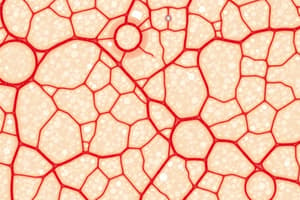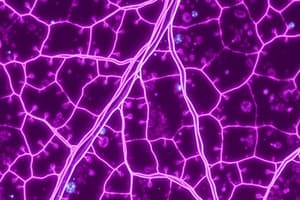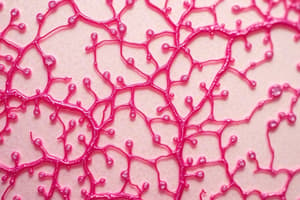Podcast
Questions and Answers
Which type of connective tissue is responsible for the storage and release of energy in the body?
Which type of connective tissue is responsible for the storage and release of energy in the body?
- Hyaline cartilage
- Dense connective tissue
- Elastic cartilage
- Adipose tissue (correct)
Which of the following is NOT a function of connective tissue?
Which of the following is NOT a function of connective tissue?
- Muscle contraction (correct)
- Energy storage
- Support and structure
- Protection of organs
- Transport of nutrients
What is the primary component of the bone matrix that provides its strength and rigidity?
What is the primary component of the bone matrix that provides its strength and rigidity?
- Chondroitin sulfate
- Elastin fibers
- Collagen fibers
- Hydroxyapatite (correct)
What type of bone growth occurs in the width of the bone?
What type of bone growth occurs in the width of the bone?
Which of the following accurately describes the difference between woven and lamellar bone?
Which of the following accurately describes the difference between woven and lamellar bone?
Which of the following is NOT a type of movement across the plasmalemma?
Which of the following is NOT a type of movement across the plasmalemma?
What is the main function of the cytoskeleton?
What is the main function of the cytoskeleton?
Which type of cell junction is responsible for anchoring epithelial cells to the basement membrane?
Which type of cell junction is responsible for anchoring epithelial cells to the basement membrane?
What is the primary function of the basal lamina?
What is the primary function of the basal lamina?
Which type of epithelial tissue is found in the lining of the urinary bladder and allows for stretching?
Which type of epithelial tissue is found in the lining of the urinary bladder and allows for stretching?
Which type of cell junction is directly involved in the formation of the basal lamina?
Which type of cell junction is directly involved in the formation of the basal lamina?
What is the primary function of microvilli in epithelial cells?
What is the primary function of microvilli in epithelial cells?
What is the difference between exocrine and endocrine glands in terms of secretion?
What is the difference between exocrine and endocrine glands in terms of secretion?
Which type of epithelial tissue is specialized for stretching and found in the urinary bladder?
Which type of epithelial tissue is specialized for stretching and found in the urinary bladder?
Which type of connective tissue fiber is strong and provides tensile strength?
Which type of connective tissue fiber is strong and provides tensile strength?
What is the main difference between exocrine and endocrine glands?
What is the main difference between exocrine and endocrine glands?
What is the primary function of white adipose tissue?
What is the primary function of white adipose tissue?
Which type of exocrine gland releases its secretions by completely breaking down the cell?
Which type of exocrine gland releases its secretions by completely breaking down the cell?
What is the primary function of fibroblasts in connective tissue?
What is the primary function of fibroblasts in connective tissue?
Which type of connective tissue fiber provides strength and flexibility?
Which type of connective tissue fiber provides strength and flexibility?
Which molecule is a major component of ground substance and contributes to its gel-like properties?
Which molecule is a major component of ground substance and contributes to its gel-like properties?
Flashcards
Plasmalemma Structure
Plasmalemma Structure
Phospholipid bilayer with embedded proteins, cholesterol, and carbohydrates.
Movement Across Plasmalemma
Movement Across Plasmalemma
Methods include diffusion, osmosis, active transport, endocytosis, and exocytosis.
Cell Organelles
Cell Organelles
Specialized structures within a cell performing distinct functions, such as energy production and protein synthesis.
Cytoskeleton
Cytoskeleton
Signup and view all the flashcards
Epithelial Tissue Functions
Epithelial Tissue Functions
Signup and view all the flashcards
Types of Epithelia
Types of Epithelia
Signup and view all the flashcards
Basal Lamina
Basal Lamina
Signup and view all the flashcards
Types of Connective Tissue Fibers
Types of Connective Tissue Fibers
Signup and view all the flashcards
Types of Connective Tissue (CT)
Types of Connective Tissue (CT)
Signup and view all the flashcards
Adipose Tissue
Adipose Tissue
Signup and view all the flashcards
Types of Adipocytes
Types of Adipocytes
Signup and view all the flashcards
Cartilage Characteristics
Cartilage Characteristics
Signup and view all the flashcards
Bone Cells
Bone Cells
Signup and view all the flashcards
Nucleus
Nucleus
Signup and view all the flashcards
Mitochondria
Mitochondria
Signup and view all the flashcards
Endoplasmic Reticulum (ER)
Endoplasmic Reticulum (ER)
Signup and view all the flashcards
Golgi Apparatus
Golgi Apparatus
Signup and view all the flashcards
Microfilaments
Microfilaments
Signup and view all the flashcards
Exocrine Glands
Exocrine Glands
Signup and view all the flashcards
Tight Junctions
Tight Junctions
Signup and view all the flashcards
Glycoproteins
Glycoproteins
Signup and view all the flashcards
Study Notes
Cell
- Plasmalemma Structure: Phospholipid bilayer with proteins, cholesterol, and carbohydrates.
- Movement Across Plasmalemma: Diffusion, osmosis, active transport, endocytosis, and exocytosis.
- Cell Organelles & Functions: Nucleus (DNA storage), mitochondria (ATP production), endoplasmic reticulum (protein/lipid synthesis), Golgi apparatus (modification/packaging), lysosomes (digestion), peroxisomes (detoxification).
- Cytoskeleton Structures & Functions: Microfilaments (shape/movement), intermediate filaments (stability), and microtubules (transport, mitotic spindle).
Epithelium
- Functions: Protection, absorption, secretion, and sensation.
- Types: Covering/lining (barriers), glandular (secretion).
- Cell Junctions: Tight junctions, adherens junctions, desmosomes, gap junctions, and hemidesmosomes.
- Basal Lamina: Thin ECM layer with type IV collagen, supports epithelium.
- Free Surface Specializations: Microvilli (absorption), cilia (movement), stereocilia (sensory).
- Terminal Web: Actin-rich structure beneath microvilli.
- Types of Covering Epithelia: Squamous (diffusion), cuboidal (secretion/absorption), columnar (absorption/secretion), and transitional (stretching).
- Exocrine vs. Endocrine Glands: Exocrine (ducts, secrete onto surfaces), endocrine (no ducts, secrete into blood).
- Types of Exocrine Glands: Merocrine (exocytosis), apocrine (partial cell loss), and holocrine (whole cell loss).
- Phenotypic Changes in Cells: Can differentiate or revert based on signals (e.g., fibroblast to myofibroblast).
Connective Tissue
- General Features: ECM-rich, supports, and connects tissues.
- -blast, -cyte, -clast: -blast (builds ECM), -cyte (maintains), -clast (breaks down).
- Major Cell Types: Fibroblasts (produce ECM), macrophages (phagocytosis), mast cells (inflammation), adipocytes (store fat), and plasma cells (antibodies).
- Extracellular Matrix: Fibers (collagen, elastin, reticular) + ground substance (GAGs, proteoglycans, glycoproteins).
Adipose Tissue
- Adipose is CT: Specialized for fat storage.
- Types of Adipocytes: White (energy storage), brown (heat production).
- Functions: Insulation, energy storage, and hormone secretion.
- Triglyceride Storage & Mobilization: Stored in lipid droplets, released via lipolysis.
- White Adipose: Large, single lipid droplet, energy storage.
- Brown Adipose: Multilocular, thermogenic (uncoupling protein-1).
Cartilage
- Structure & Characteristics: Avascular, flexible ECM, chondrocytes in lacunae.
- Development: Mesenchymal cells differentiate into chondroblasts.
- Types & Locations: Hyaline (joints, ribs), elastic (ear, epiglottis), fibrocartilage (IV discs, menisci).
- Function: Cushioning, support, and flexibility.
- Hyaline Cartilage Repair: Limited due to avascularity; forms fibrocartilage instead.
- Epiphyseal Growth Plate: Zones of cartilage regulating bone growth.
- Perichondrium: Dense CT layer surrounding cartilage, provides nutrients.
Bone
- Structure: Compact (dense, outer layer), spongy (trabecular, marrow-filled).
- Bone Matrix: Collagen (type I), hydroxyapatite (calcium phosphate).
- Bone Cells: Osteoblasts (build), osteocytes (maintain), osteoclasts (resorb).
- Bone vs. Cartilage: Bone is vascular, rigid; cartilage is avascular, flexible.
- Woven vs. Lamellar Bone: Woven (immature, disorganized), lamellar (mature, strong).
- Osteon: Structural unit of compact bone, with concentric lamellae.
- Ossification Types: Endochondral (cartilage model), intramembranous (direct from mesenchyme).
- Appositional vs. Interstitial Growth: Appositional (width), interstitial (length).
- Hormonal Calcium Regulation: PTH increases blood Ca²⁺ (stimulates osteoclasts), calcitonin decreases it (inhibits osteoclasts).
Nucleus
- Nucleus Structure: Nuclear envelope, nucleoplasm, nucleolus (rRNA synthesis), chromatin (DNA + proteins).
- Stem Cells: Undifferentiated cells that can self-renew and differentiate into specialized cells.
Studying That Suits You
Use AI to generate personalized quizzes and flashcards to suit your learning preferences.




